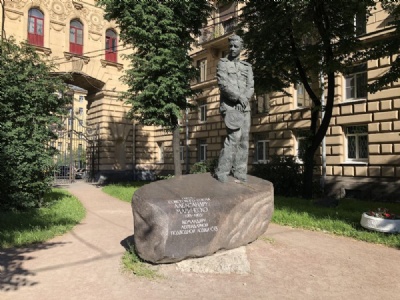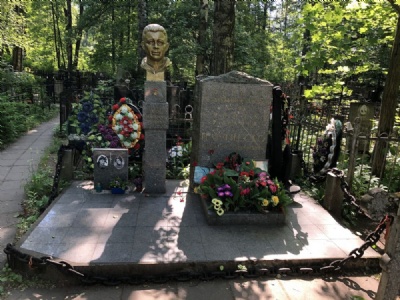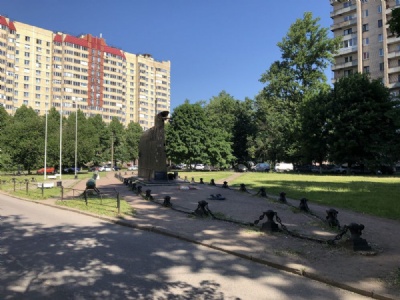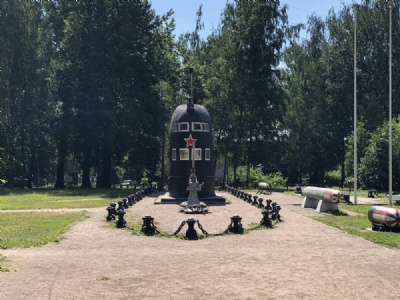Saint Petersburg - S13
The Soviet submarine S-13 was Stalin class submarine and began construction in October 1938 and was put into service in july 1941. It came to belong to the Soviet Baltic fleet and served (patrolled) in the Baltic. S-13 successes in the early years were modest and only after the sinking of the German transport and cruise ship, MV Wilhelm Gustloff on 30 January 1945, it became famous. Gustloff had left the port of Gdynia (german Gotenhafen) with about 10,500 passengers. An overwhelming majority were civilians on the run from the approaching Soviet armies, and some were military personnel. Gustloff was discovered by S-13 under Captain Alexander Marinesko’s command shortly after she left Gdynia’s port. Marinesko then pursued Gustloff and under the cover of darkness, the S-13 went up to the surface and fired three torpedoes, all of which hit Gustloff on port side.
MV Wilhelm Gustloff was one of two cruise ships built and owned by the German leisure organization, Kraft Durch Freude, KdF, (freely translated, Strength Through Joy). The second ship was MV Robert Ley. Gustloff was named after the Swiss Nazi leader who had been murdered in Davos in 1936 while Robert Ley was named after the leader of the German labor front. The construction of the Gustloff began in 1936, launched in 1937 and completed in 1938. It was about 208 m long, about 24 m wide and had a capacity of about 1500 passengers. Both Gustloff and Ley were built as cruise ships where the German (nazi) worker would receive a well-deserved subsidized vacation for his contribution for the German people. Cruises went to the coasts along both Norway and Italy. But Gustloff also visited Stockholm in connection with the Lingiad games in July 1939 when the German gymnastics squad was quartered on the ship.
However, both Gustloff and Ley’s careers as cruise ships became short-lived. Already in connection with the outbreak of the Second World War, both were requisitioned as a hospital ships. In November 1940, Gustloff moved to Gdynia (german Gotenhafen) and became quarter for about 1,000 cadets to the German submarine fleet. Gustloff remained in port until the autumn of 1944 when, together with other ships, it was requisitioned as a evacuation ship to evacuate civilians and military personnel westward fleeing from the advancing Soviet Red Army.
Gustloff left port of Gdynia at noon January 30, 1945, with about 10,500 passengers on board (data with a lower number of passengers also occurs). There was an icy wind and the temperature was minus 18 celsius. An overwhelming majority were civilians in desperate flight from the advancing Red Army but perhaps about 1000 were military evacuated personnel. Gustloff was discovered by S-13 under Captain Alexander Marinesko’s command shortly after she left Gdynia’s port. Marinesko then pursued Gustloff and under the cover of darkness, the S-13 went up to the surface and fired three torpedoes, all of which hit Gustloff on port side.
Gustloff sank in about 40 minutes and over 9,000 passengers perished. Many of them after having ended up in the icy water or being trapped inside the ship. This makes the sinking of Gustloff the single largest maritime disaster in history. From a German point of view, strong criticism was directed at the Soviet Union because it was considered to be a civilian transport ship without military significance and thus a war crime. A criticism that to some extent still remains in the western European history description. But to Marinesko’s defense, it was difficult for him to know what Gustloff transported. There was darkness and no reliable information was available. Marinesko probably acted as any other captain would have done, he discovered a enemy ship and acted based on what was expected of him as captain of a submarine.
Just over a week later, the S-13 sank another German ship in the waters off East Prussia. The ship, General von Steuben, transported about 5,200 passengers, half of whom were injured soldiers, while the others were a mixture of civilians and others. Just before midnight on February 9, the S-13 launched two torpedoes hitting Steuben’s starboard side. Steuben sank in only twenty minutes. An estimated 4,500 of the passengers perished. Before S-13 left the port of Porkkala January 11, 1945, Captain Marinesko awaited martial law of alcoholism and disobidience. Which meant that his superiors did not consider him suitable as a war hero. Although he became the most successful submarine captain in the Soviet navy during the Second World War, he was therefore denied the title of hero of the Soviet Union.
Before S-13 went out on mission, in where Gustloff was sunk, Marinesko had problems with his superiors. He was a little too fond of alcohol and prostitutes, undisciplined and did not always follow the protocol. But he was a respected commander by his crew which may well have been the reason Marinesko was allowed to command S-13. Marinesko in turn may have felt that this mission gave him an opportunity for rectification. When Gustloff appeared, it may have been too tempting for Marinesko to let pass. A sinking of such a large tonnage could be to his favour and impress Marinesko’s superiors. That there were probably civilians on board may be. There was a pent-up desire for revenge on the part of the Russians to make up for the war crimes the germans had inflicted on the soviet population for almost four years. The S-13 crew all came from Leningrad, a city besieged by the Germans between 1941 and 1944, where about 800,000 civilians died, mainly from starvation. Everyone on board the S-13 had a relative who died during the siege. For them it was probably indifferent if there were German civilians or not on board Gustloff.
But after the war, Marinesko was demoted and discharged from the navy. His craving for alcohol and women also did not subside. Marinesko died in cancer 1963 at the age of 50. In 1990 Marinesko was rehabilitated and he was posthumously awarded the title, Hero of the Soviet Union, by the then party secretary Mikhail Gorbachev. The S-13 was taken out of service in 1954 and scrapped in 1957.
Current status: Museum (2021).
Location: 59°58'59.22" N 30°23'56.50"E
Get there: Metro to Ploschad Lenina Station and from there bus.
Follow up in books: Prince, Cathryn: Death in the Baltic (2014).




Marinesko is buried at Bogoslovskoye cemetery in northern Saint Petersburg. Nearby there is a submarine museum named after him where S-13 is part of the exhibition. In the south of Saint Petersburg a statue has been erected of him as late as 2013, probably coinciding with his centenary. There is also a street named after him.
MV Robert Ley was heavily damaged in a British bombing raid on Hamburg, March 9, 1945, when the ship was in port. In 1947 it was towed to Britain and scrapped.